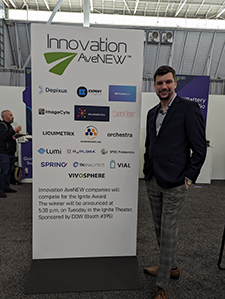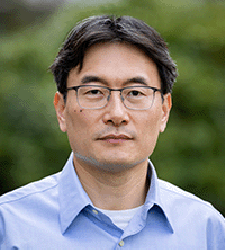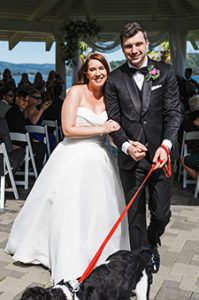
In less than a year after receiving his SLAS Graduate Education Fellowship Grant, Samuel Berryman moved from grant winner to Innovation AveNEW exhibitor. His academic research rapidly expanded into a start-up company with a marketable product – all with the support of SLAS and its network of life sciences leaders.
“The first pass through any life sciences experiment is always about learning – don’t be afraid to be messy, make mistakes or break things. It’s the second pass that’s about refining and reproducing,” says Samuel Berryman, a Ph.D. candidate in the Department of Mechanical Engineering from the University of British Columbia (UBC, Vancouver, BC, Canada), and recipient of the 2023 SLAS Graduate Education Fellowship Grant.

Samuel Berryman.
Berryman is a rapid-fire solution finder as he works to overcome the limitations associated with the analysis of chimeric antigen receptor T (CAR-T) cell therapies. He even wrote in his application for the SLAS grant, “I am best suited for research because I cannot just work on a small portion of a project. I need to take it apart and learn how every aspect of it fits together.” Berryman laughs and affirms that this is still the case one year into his two-year grant.
In the process of advancing his research objectives outlined in the grant proposal, Berryman invented a platform to evaluate CAR-T cells at the single-cell level, developed a process to manufacture the technology, started a business – ImageCyte – and applied to be on Innovation AveNEW at SLAS2024.
“We’re expanding the work in a number of different ways, but starting a company was the really big surprise from the last year!” says Berryman. “Our technology has many applications beyond what we originally envisioned. I’ve been working on new projects that potential customers would like to see, ranging from single-cell drug screening to spheroid generation and completing quick proof-of-concept demonstrations.”

Dr. Hongshen Ma.
Sharing this vision is Berryman’s advisor, Hongshen Ma, Ph.D., a UBC professor who is also his partner in the new business venture. “We have all these fantastic AI tools that have been used to analyze images to identify people and objects. Now we can use this approach to assess the properties of therapeutic cells,” Ma explains.
“Currently, it’s difficult to take pictures of cells and associate them with their type or function,” Ma continues. “While this information is likely available in cell images, we need a good way to associate the images with outcomes of assays. The device that Sam has built will be good for this – we can put single cells into these chambers, take high-quality images, and then assay each cell to associate the cell image with its function and behavior.” Ma adds that the resulting data can be compiled, shared and built upon by other scientists.
Berryman’s device features an array of millions of nano-well chambers that have been photolithographically fabricated inside standard glass-bottom micro-well plates. Researchers deposit single cells into individual chambers to observe cell characteristics ranging from cell phenotypes to dynamic behaviors.
In his research, Berryman is placing individual CAR-T cells and target cancer cells in the nano-wells to perform a killing assay to identify functionally superior CAR-T cells. He will acquire high-quality images of these cells to use AI approaches to identify cell morphologies indicative of highly functional CAR-T cells. This work will provide an improved assay to perform quality control of CAR-T cell function.
Eyes Wide Open
Berryman, whose academic pursuits switched from mechanical to biomedical engineering during his graduate studies, appreciates the constant opportunity to continue learning in life sciences. “You don’t just learn one thing and then do it over and over again. You have to constantly be learning and adapting. With everything you do, there is the opportunity for it to have a lasting impact in medicine, which is deeply rewarding,” he comments.
He compares this to the manufacturing process associated with his newly minted nano-well device. “It’s one thing to make a device that you use a couple of times in an academic lab, however, when you want to make devices that could be used by external users, there’s another threshold to meet in terms of quality control,” comments Berryman.
At the start of his grant, Berryman met with manufacturing companies to discuss mass producing the device by licensing the intellectual property, but it quickly became apparent that the best option was to develop a process to manufacture the device himself.

Samuel presenting at SLAS2024.
The opportunity on SLAS Innovation AveNEW offered Berryman a chance to showcase the device and present its usefulness to a broader audience of life sciences researchers.
“Taking part in Innovation AveNEW at SLAS2024 and giving an SLAS Ignite presentation was an incredible experience for us, especially being a company at such an early stage,” Berryman comments.
“While we had the opportunity to build brand awareness with potential customers, we found that it was even more important to make initial contact with many of the exhibiting companies. Following the conference, we are going to be translating those conversations into new manufacturing opportunities, development projects and potential distribution agreements. This was all made possible by the sponsorship we received through the Innovation AveNEW platform. We highly recommend other life sciences start-up companies take advantage of the opportunity. It is an accelerant that will drive your company towards success.”
With A Little Help from Friends
“The SLAS Graduate Education Fellowship Grant is a great opportunity, because it gives you the platform to present your research first and foremost. It also opens the door to taking part in the SLAS community,” says Berryman. “Whether the applicant is looking for a postdoc, a job in industry or – as in my case – a commercial partner, there are so many opportunities to connect with people at SLAS.”

Samuel with his wife, Rachael – Photo courtesy of Jesse Holland Photography.
Berryman describes himself as fortunate that SLAS is sponsoring the journey of his technology from research to commercialization and adds that the encouragement from Ma also has been invaluable.
“He’s been extremely supportive along the way, and as we commercialize this device together, we’re shifting from me working for him to working together as a team. It’s an interesting transition,” Berryman says, adding that he continues to look for ways to pay forward the support he’s received.
“You learn a lot from the people you mentor and teach. Mentoring is a great opportunity to help solidify your own knowledge,” he comments. For the past five years, Berryman has been a teaching assistant for the mechatronic product design course at UBC. “I helped run the labs and developed some of the course design. I loved doing this. Among the 40 or so people that you teach, you develop a few different approaches to help others understand the subject matter. This gives you an opportunity to learn the material more thoroughly.”
A try- and try-again approach is one Berryman recommends to others as they pursue science. “There are so many positive learning

Samuel playing golf.
outcomes that develop from making small mistakes and escaping from the lab for a break,” comments the newly-wed Berryman, who enjoys spending hours out of the lab with his wife, Rachael, and the couple’s dog, Dante – and occasionally hitting the links for a few holes of golf.
“Science is not easy,” he says. “The advice I give is, don’t restrict your research or your ambition to familiar territory – that’s not how you learn. Instead, seek excellent mentors to guide you through this unknown territory and make your decisions based on the potential to expand your knowledge base. Even if you fail along the way, you gain wisdom to use toward whatever comes next.”
*****
SLAS (Society for Laboratory Automation and Screening) is an international professional society of academic, industry and government life sciences researchers and the developers and providers of laboratory automation technology. The SLAS mission is to bring together researchers in academia, industry and government to advance life sciences discovery and technology via education, knowledge exchange and global community building.
SLAS publishes two peer-reviewed and MEDLINE-indexed scientific journals, SLAS Discovery and SLAS Technology. For more information about SLAS and its journals, visit www.slas.org/journals.


